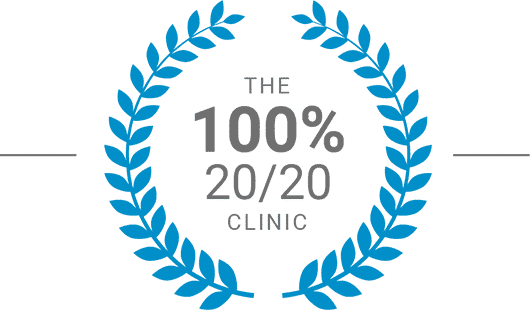Book Your Free Consultation
Mr David Allamby
MD, FRCOphth, FRCS
When the first Photorefractive Keratectomy (PRK) laser vision correction surgery was performed in 1989, there were a lot of unknowns regarding the risks, effectiveness, and longevity of LASIK eye surgery.
Back then, complications such as glare or blurred vision because of a residual prescription, haze, double vision and infections occurred much more frequently.
Fast forward over 30 years and the laser eye surgery techniques and equipment used are far more advanced, meaning the risks involved in having laser eye surgery are minimal and the outcome is far more precise.
Despite laser correction now being safer than it has ever been, with various complications being greatly reduced or even eliminated, treatments like LASIK are still surgery and should always be treated as such – with due care and consideration.
LASIK surgery is considered safe and has a strong track record. Complications are rare, and most people are happy with the results. Some side effects, like dry eyes and temporary visual disturbances (such as glare), are relatively common but typically resolve within weeks or months, though a few people may find them to be more persistent.
However, there’s more to it than that.
Having LASIK surgery is the same as having any other surgical procedure – you’re safe as long as your surgeon is qualified, experienced and reputable, and the clinical setting isn’t overly commercial.
We often compare having laser eye surgery to driving. Is driving safe? Well, that depends on the driver, the condition of the car and the environment they’re driving in.
The chances of experiencing complications from LASIK, including various minor ones, has been documented to be less than one per cent.
Most LASIK complications actually arise when the patients are not good candidates for the procedure.
This ultimately comes down to the surgeon and clinical setting.
If it's a profit-oriented environment where less time is spent on assessment and selection and more time is spent trying to get as many people as possible treated, laser eye surgery risks will rise.
Despite this, serious complications with LASIK eye surgery are actually rare, providing the patient is suitable and known risks have been reduced e.g. from pre-treatment of any dry eye to improve post-operative healing and recovery.
But while this treatment might seem risky, all vision correction options have an element of risk. For example, it is well known that there is a higher risk of infection if you wear contact lenses long-term than from LASIK eye surgery.
Providing you are deemed a suitable candidate and the surgeon is reputable and experienced, laser eye surgery risks are extremely rare and the procedure is incredibly safe.
Although you may not think it, the biggest risk in the LASIK process arises at the consultation stage.
Safety is primarily about only operating on suitable candidates.
PRK and LASIK eye surgery outcomes are almost always favourable for those who don’t have any indications of increased risk and are suitable to proceed; however, not everyone is deemed a suitable candidate.
A good indication of the success of any clinic is the percentage of patients who require a second ‘top-up’ procedure to enhance the result, known as an enhancement or re-treatment.
These retreatments can be caused by over- or under-correction, which is where too little or too much tissue is removed from the corneal tissue during the procedure.
The LASIK protocols created and followed at Focus Clinic have led to a remarkably low re-treatment rate, at less than 1% of typically short-sighted cases (2014 data), compared to between 3% and 9% in published studies.
Primary LASIK treatments, even for high levels of myopia, remain consistently accurate and relatively risk-free.
As with any medical intervention, there are possible risks and side effects that can occur.
All of these will be discussed at your consultation. It’s important that you are aware of the potential issues before you go ahead with the surgery and discuss any concerns you have at your consultation.
While the LASIK process is incredibly safe, there is still a chance that patients can develop some side effects. Your eye surgeon should discuss potential risks with you and explain why the procedure selected will be an effective treatment in your circumstances.
The most common risks for laser surgery patients are:
The most prevalent complication reported after laser eye surgery is persistent dry eyes, with published studies showing rates of up to 20-50% of patients.
At Focus Clinic, correct patient selection and pre-treatment of any existing dry eye have dramatically improved these rates, dropping the post-op incidence to less than 1% of our laser eye surgery patients.
It is important to note that it is common for women to suffer from dry eyes after menopause, but men can also be affected by this condition in later life. Smokers may also suffer from dry eyes.
Dry eyes before treatment can increase the risks of chronic eye dryness after LASIK, so it is highly recommended that if you suffer from dry eyes you get this condition treated before laser eye surgery is performed.
If your eyes are very dry beforehand, your risks are increased and it is likely better to avoid laser vision surgery. Another option for selected short-sighted patients is an ICL (implantable contact lens) with far less risk of induced dryness.
Other, more rare, complications of laser eye surgery include infections which can occur in roughly 1 in 10,000 cases.
That figure is much less common than an eye infection leading to vision loss from contact lenses, which occurs in roughly 1 in 2,000 cases.
Hence, contact lenses are at least 5 times more likely to cause loss of vision from micro-organisms compared to LASIK surgery.
Some patients experience halos – which show as circles around bright lights – or glare after surgery, but these symptoms can resolve as the eyes recover from the procedure.
These can occur after laser treatment and are mainly linked with the degree of prescription treated – it is most often seen in high and extreme myopia cases, typically of -8.00 dioptres and higher.
Overall, the risk of a complication requiring further treatment, by LASIK or any other technique, is approximately 1 in 1000, and where there is no significant visual loss.
The chance of a more serious complication which would affect vision in one eye or the other, or both, is 1 in 10,000.
There are two types of laser eye surgery, which give surgeons the ability to choose the best procedure for the patient, significantly reducing the risks of problems occurring post-surgery.
Sometimes clinics list these as ‘optional extras’ but they are essential to getting the safety available from modern laser eye surgery.
Wavefront optics (often referred to just as ‘wavefront’) is an advanced laser treatment pattern that leaves a more natural shape to the curvature of the cornea after treatment.
Older non-wavefront laser treatments tended to flatten the central cornea without maintaining its so-called ‘aspheric’ shape. (This aspheric shape is found in high-quality camera lenses, and gives a sharper, crisper focus.)
You may see the terms ‘wavefront optimised’ and ‘wavefront-guided’, but there is no statistical difference in outcomes between the two, confirmed by multiple research studies.
Wavefront surgery has meant that a lot of the side effects previously associated with laser vision correction (such as halos and glare at night) are now much rarer than before.
The take-home message is always to choose the ‘wavefront’ option. At Focus Clinics, we only offer wavefront-based treatments.
Modern LASIK surgery uses two lasers. The first is a so-called ‘femtosecond’ laser which creates the flap in the top layers of the cornea, rather than using an old-fashioned blade system, called a microkeratome.
Microkeratome LASIK surgery is a cheaper alternative to using a more sophisticated laser, where the surgeon will use a scalpel to manually cut the corneal flap to allow the laser to correct the site.
However, you are more likely to experience adverse reactions to this type of surgery as a surgeon using a blade device will never be able to cut this flap as precisely and cleanly as a laser.
You are also at a greater risk of reduced corneal strength and persistent dry eyes, as the healing process is slower with potentially thicker flaps made by the blade, than when the corneal flap is created by a laser.
For this reason, Focus Clinics only offers laser-created flaps in their LASIK surgery.
The femtosecond laser is the first stage of the procedure, with the second stage involving a different laser to correct the curve of the cornea, thus correcting vision.
We provide you with a course of antibiotic eye drops following your surgery to help prevent any infections or inflammation and minimise any symptoms of dry eyes.
So, if you’re considering laser eye surgery, is it worth the risk?
Ultimately, that’s for you to decide, but the data shows that laser eye surgery is an incredibly safe procedure.
In fact, you’re 5 times more likely to suffer from vision problems as a result of wearing contact lenses than from corrective surgery.
If you’re getting tired of wearing glasses or contact lenses and you’re considering refractive surgery then get in touch today and a member of our team will be happy to discuss your suitability and talk you through the different options available to you.
Further reading if you're considering LASIK surgery:
Book a FREE* Consultation
To get a better idea of how we can help you, and also the different types of services we offer, book a consultation now.

100% 20/20 vision
Focus Clinic has a remarkable 100% success rate for 20/20 vision. We know of no other clinic that has matched these results. There is a big difference between, for example, 98% and 100% success, especially if you are in the 2%.

10 year guarantee
Your 10 Year Guarantee means you can return at any time if you have additional questions on the quality of your vision. If you have distance vision correction for short-sight then any repeat laser eye treatments to correct a return of myopia in the first 10 years are included free of charge.*

Most trusted eye treatment clinic
We have the highest trust rating of any ‘eye treatment’ rated clinic, according to independent review site TrustPilot. With an outstanding 9.9 out of 10, when it comes to your eyes, choose the clinic that actual patients trust the most.
*Terms and conditions apply, excludes any age-related changes and conditions unrelated to the primary treatment